This set of Heat Transfer Operations Multiple Choice Questions & Answers (MCQs) focuses on “Climbing Film Evaporator”.
1. Climbing film evaporator can be used only as a single effect evaporator.
a) True
b) False
View Answer
Explanation: Climbing film evaporators are generally used as a multiple effect type ones, usually multiplied with a falling film evaporator.
2. Which one of the following statement is incorrect about the factors leads to single effect operation of climbing film evaporator?
a) When the vapour is contaminated and cannot be recycled
b) The feed is highly corrosive, requiring expensive construction materials
c) The liquid has low vapour pressure
d) The energy cost to produce the steam heating is low
View Answer
Explanation: When the liquid has low vapour pressure, then its evaporation is easier and hence the recycled vapour can be reused to heat in the subsequent effects.
3. Which one of the following statements is correct about the nucleate boiling phenomenon in climbing tube evaporators?
a) There is no nucleate boiling
b) There is nucleate boiling throughout
c) Nucleate boiling near the entrance but not later
d) Nucleate boiling near the exit and nowhere else
View Answer
Explanation: We use steam as the heating agent here, so at the entrance, there is little nucleate boiling that occurs but not elsewhere.
4. Climbing film evaporators are necessarily Long tube evaporators.
a) True
b) False
View Answer
Explanation: Climbing film evaporators are a subclass of long tube evaporators along with falling film evaporators.
5. How does the fluid in climbing film evaporator rise in the tubes?
a) There is a pump at the bottom that pushes it
b) Pressure gradient is applied
c) The vapour produced then pushes the fluid upward
d) Temperature gradient causes convection that moves upward
View Answer
Explanation: The vapour produced while heating the wall presses the liquid against the walls of the tubes and causes the ascending force of this liquid that lifts it upward.
6. Which one of the following is not a use of climbing tube evaporator?
a) Thermal desalination
b) Juice concentration
c) Pharmaceuticals
d) Feed-water purification
View Answer
Explanation: Feed-water is corrosive and fouling, hence it cannot be used with climbing film evaporators.
7. What is the pressure used for thermal desalination of water in climbing film evaporators?
a) Close to zero
b) Very high around 3-4atm
c) Atmospheric pressure
d) Just below 1atm
View Answer
Explanation: The thermal desalination of water is carried out in vacuum conditions that allow for the use of lower temperatures. It is most commonly used with climbing film evaporators with vacuum conditions at the top basket.
8. Why are food, pharmaceuticals and sensitive fluids used in climbing tube evaporators?
a) The pressure is very low
b) There is very less temperature gradient
c) The fluid is not exposed to high temperature for a long period of time
d) Its heated by natural convection
View Answer
Explanation: The food and pharmaceutical industry requires handling of delicate products that are sensitive to high temperature for long periods of time. Climbing film evaporators can operate quickly and efficiently to avoid exposing the product to high temperatures which may damage its quality.
9. Which one of the following is not an advantage of climbing film evaporator?
a) Low residence time
b) High efficiency
c) Low temperature difference required
d) Low pressure operation
View Answer
Explanation: The rising film evaporator usually do not have high efficiency, this is majorly due to its low residence time and the requirement of driving force to drive the liquid upward which may sometimes prove to be ineffective.
10. Climbing film evaporators are _________ falling film evaporators.
a) Better than
b) Have more efficiency than
c) Not as good as
d) Considered over
View Answer
Explanation: Falling film evaporators are normally selected in place of the rising film evaporators because both are having same advantages as rising film evaporators and it also has additional benefits of the efficiency. There is an independence of driving force in falling films that make it more fruitful.
11. Recognize the correct flow direction in rising film evaporator.
a) 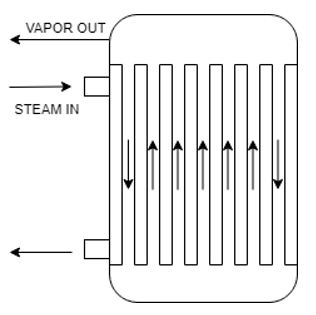
b) 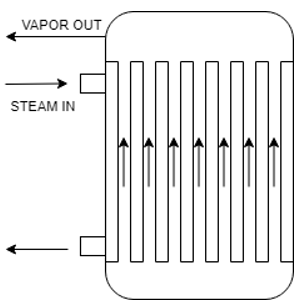
c) 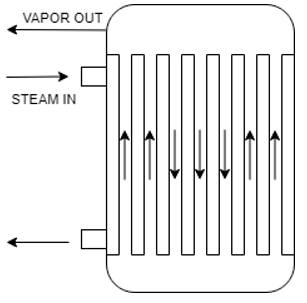
d) 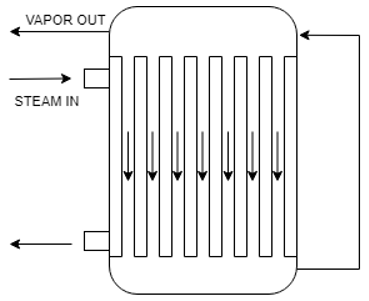
View Answer
Explanation: In a rising film evaporator, the direction of fluid is usually upward and recycle is generally not used as the concentration of the fluid at the top is quite high.
12. Which one of the following is a Long tube evaporator?
a) 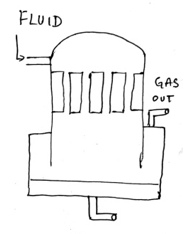
b) 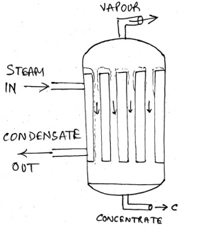
c) 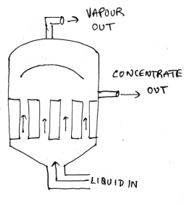
d) 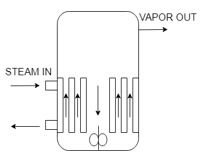
View Answer
Explanation: The given answer is a rising tube evaporator recognized from the direction of flow of the fluid in it and the length of the tubes. It has longer tubes and vapour escapes from top as well as the direction of fluid flow is upward.
Sanfoundry Global Education & Learning Series – Heat Transfer Operations.
To practice all areas of Heat Transfer Operations, here is complete set of 1000+ Multiple Choice Questions and Answers.
If you find a mistake in question / option / answer, kindly take a screenshot and email to [email protected]
- Check Heat Transfer Operations Books
- Check Chemical Engineering Books
- Apply for Chemical Engineering Internship
- Practice Chemical Engineering MCQs
